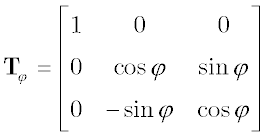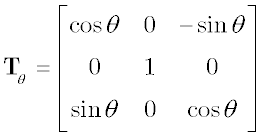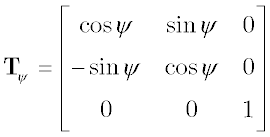Rotations
Block-library: DUBSI
|
  
|
|
The rotation blocks rotx, roty, and rotz, can be used to express a given vector in terms of a new Cartesian coordinate frame, where the new frame has the same origin as the old, but a different orientation. The three blocks implement transformations for rotations around the positive x, y, and z-axes of a right-handed orthogonal reference system, respectively. The orientation of one three-dimensional reference frame with respect to another can always be described by a sequence of these three plane rotations. The transformation equation in each of these blocks can be expressed by the following generic vector formula: Where u is the input vector, y is the output vector, and T1—>2 is the transformation matrix; the transformation matrix contains the direction cosines for a rotation from reference frame 1 to reference frame 2. Let φ, θ, and ψ define the rotations around the x, y, and z-axes, respectively, and let Tφ, Tθ, and Tψ define the three corresponding rotation matrices. Then the following equations apply:   
Obviously, rotx implements equation (1) with T1—>2 = Tφ, roty uses equation (1) The blocks rotx, roty, and rotz require the following two input signals:
rotx, roty, and rotz do not require any block-parameters. By connecting these blocks in sequence, an arbitrary rotation of the reference frame can be obtained. |
|
| Contents Previous Next | April 15, 2003 |